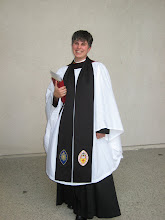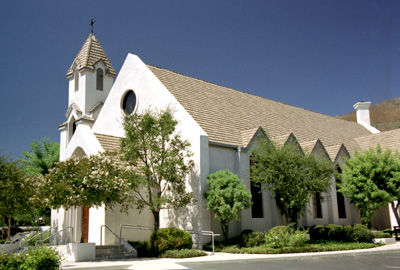
(Episcopal News, Los Angeles) -- The raging Montecito wildfire has destroyed historic Mount Calvary Retreat House, staff and Santa Barbara County officials have confirmed.
The resident brothers, members of the Order of the Holy Cross, and staff are safe following evacuation, said Nancy Bullock, program director for Mount Calvary, speaking by phone from All Saints by-the-Sea Church in Montecito.
Bullock said that All Saints is currently working to determine if any parishioners have lost homes in the blaze, which has claimed more than 100 residences across 2,500 acres. Bullock's husband, Jeff, is rector of the parish.
Bishop J. Jon Bruno, who is in close telephone contact with clergy leaders in the Santa Barbara area, asks the prayers of the diocesan community for all those affected by the fire. The bishop and staff of the Diocese of Los Angeles have pledged their support in assisting the coordination of fire recovery efforts. Checks, payable to the Treasurer of the Diocese and earmarked "Montecito Fire Recovery" may be sent to the Bishop's Office, 840 Echo Park Ave., Los Angeles, CA 90026.
Mount Calvary's prior, the Rev. Nicholas Radelmiller OHC, is leading the brothers and staff in assessing next steps of response to the fire damage.
Bullock said the brothers and staff at Mt. Calvary, were able to leave with some of the hilltop retreat house's valuable art treasures, as well as computer records, "but so much is lost."
Mount Calvary staff will assist groups and individuals in seeking alternate locations for upcoming retreats, all of which are now cancelled owing to the fire, Bullock said. The Cathedral Center retreat center in Los Angeles is available to assist this process.
At Santa Barbara's Trinity Church, rector and deanery co-dean Mark Asman is meeting with staff and volunteers to assess the situation and crisis response. Further information will be reported through the Episcopal News email list as soon as it becomes available, Asman said.
Asman said Trinity Church's rectory and parish house were able to accommodate the brothers overnight November 13. St. Mary's Retreat House, an Episcopal Church site near the Santa Barbara Mission, has also extended hospitality, although it was subject to a temporary evacuation November 13.
Calif. Gov. Arnold Schwarzenegger has declared the fire zone a disaster area as fire fighters continue to work to contain the blaze.
Mount Calvary Retreat House, with its panoramic ocean views, was founded in 1947 by the Order of the Holy Cross, based in West Park, N.Y.
--Report filed by Bob Williams, canon for community relations, Diocese of Los Angeles.



 Dear Sisters and Brothers,
Dear Sisters and Brothers,



































